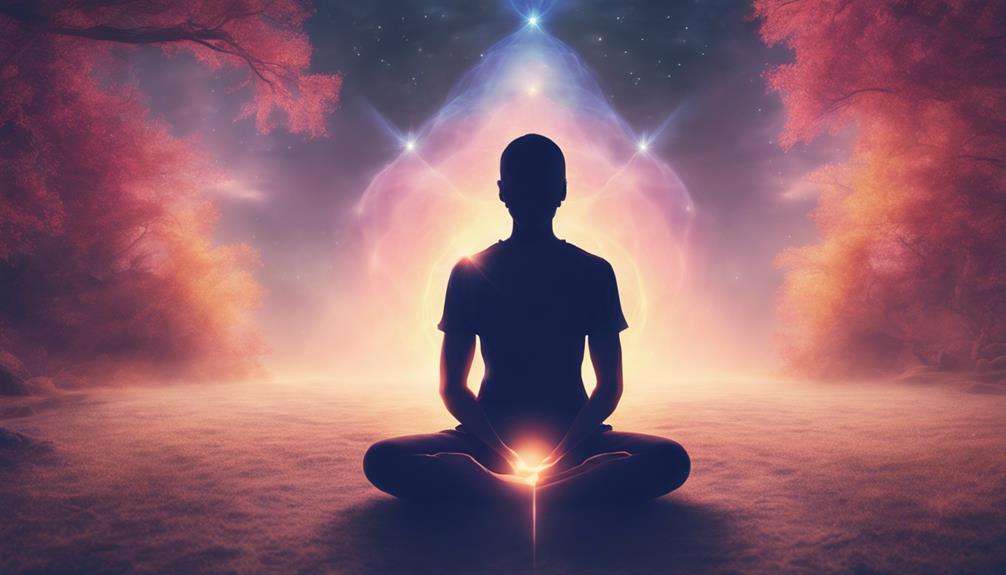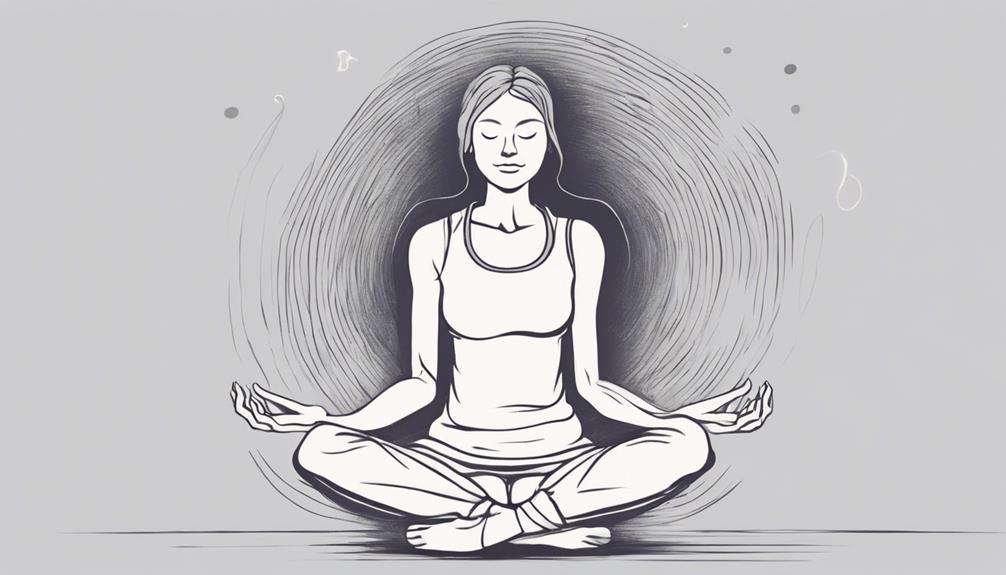When you're experiencing persistent lower back pain, have you ever tried guided relaxation as a means of relief?
The soothing techniques used in guided relaxation can work wonders for managing pain by addressing the mind-body connection in a profound way.
By exploring the intricate relationship between stress, pain perception, and relaxation, you can uncover a compelling rationale behind the efficacy of guided relaxation in alleviating discomfort and enhancing your overall pain management strategies.
Key Takeaways
- Guided relaxation activates pain-modulating brain regions and releases endorphins, acting as natural painkillers.
- It regulates stress response, decreases pain levels, and improves pain tolerance.
- Techniques like breath focus and visualization shift pain signal processing and reduce pain perception.
- Combining guided relaxation with medication enhances pain relief, quality of life, and overall well-being.
The Science Behind Guided Relaxation
Guided relaxation techniques such as meditation and visualization activate specific brain regions associated with pain modulation, offering a natural approach to managing discomfort. For chronic pain patients, incorporating meditation and guided imagery into their daily routine can significantly reduce pain intensity and improve pain tolerance. Studies have shown that these practices trigger the release of endorphins, which act as natural painkillers in the body. By engaging in guided relaxation, individuals can effectively regulate their stress response, leading to a decrease in pain levels over time.
Research has consistently supported the efficacy of guided relaxation in pain management. Meta-analyses have highlighted the positive impact of these techniques on reducing pain and enhancing overall well-being. By understanding how meditation and relaxation techniques influence the brain's pain modulation pathways, chronic pain patients can harness these strategies to alleviate their symptoms and enhance their quality of life. Embracing guided relaxation as part of a comprehensive pain management plan can empower individuals to take an active role in their health and well-being.
Understanding Pain Perception
In the intricate realm of pain perception, sensory, cognitive, and emotional factors intricately intertwine to shape your experience of discomfort. Pain isn't solely a physical sensation; it involves complex processes in the brain where signals are processed and interpreted. Cognitive factors, such as your expectations, mood, and past experiences, play a crucial role in how you perceive pain. In cases of chronic pain, the brain can undergo structural and functional changes, altering the way it processes pain signals.
Mindfulness practices like guided relaxation can help reduce pain perception by engaging these cognitive and emotional processes. By focusing your attention on the present moment during guided relaxation sessions, you can enhance your awareness of sensations without judgment. This heightened awareness can lead to a shift in how your brain processes pain signals, potentially decreasing the intensity of discomfort you feel.
Understanding the intricate interplay of sensory, cognitive, and emotional factors in pain perception is key to effectively managing and reducing pain through techniques like guided relaxation.
Impact of Guided Relaxation on Pain

Activating the parasympathetic nervous system through guided relaxation techniques like imagery and meditation can significantly reduce pain perception. Guided relaxation is a powerful tool in pain management, offering various benefits to individuals dealing with chronic pain:
- Stress Reduction: By lowering cortisol levels, guided relaxation helps decrease stress, which in turn can alleviate pain sensitivity.
- Mindfulness: Guided relaxation enhances mindfulness and self-awareness, enabling individuals to develop effective coping mechanisms for managing chronic pain.
- Improved Pain Tolerance: The practice of guided relaxation leads to reduced muscle tension, better sleep quality, and an overall increase in pain tolerance.
Engaging in guided relaxation not only provides relief from pain but also empowers individuals to take an active role in their pain management journey. By tapping into the body's natural relaxation response, guided relaxation serves as a valuable tool for enhancing overall well-being and quality of life.
Neurological Effects of Guided Relaxation
Engaging in guided relaxation techniques can lead to significant neurological effects that alter the brain's processing of sensory information related to pain signals. When you practice guided relaxation, you're actively engaging the parasympathetic nervous system, promoting a state of relaxation that helps reduce the body's stress response. This reduction in stress can have profound effects on your health, particularly in managing chronic pain conditions. By incorporating guided relaxation into your routine, you may experience decreased pain perception as the brain's processing of sensory information related to pain signals is modified.
Studies have shown that guided relaxation techniques such as visualization and progressive muscle relaxation can positively impact brain regions involved in pain processing. Through neuroimaging, researchers have observed changes in neural activity that contribute to decreased pain sensitivity and improved pain management. By consistently practicing guided relaxation, you're actively harnessing the neurological effects that can help alleviate physical discomfort and enhance your overall well-being.
Techniques for Pain Relief

When it comes to finding relief from pain, focusing on your breath, using visualization techniques, and practicing progressive muscle relaxation can be incredibly helpful. These techniques have been shown to calm your mind, release muscle tension, and reduce the perception of pain.
Incorporating these methods into your guided relaxation practice may offer you significant relief and promote a sense of well-being.
Breathing for Pain Relief
To alleviate pain and promote relaxation effectively, mastering proper breathing techniques is key. When dealing with pain, incorporating specific breathing exercises can trigger the body's relaxation response, reducing the perception of pain and enhancing overall well-being.
Deep breathing techniques play a crucial role in calming the sympathetic nervous system, which in turn can lower stress hormone levels and alleviate pain sensations. Additionally, practicing mindful breathing not only enhances oxygen flow and circulation but also helps reduce muscle tension often associated with pain.
Controlled breathing techniques have been proven to boost pain tolerance, decrease anxiety levels, and provide a sense of control during painful episodes, ultimately aiding in pain management.
Visualization Techniques
Visualization techniques offer a powerful tool for reducing the perception of pain through the use of mental imagery. When you engage in visualization practices, such as imagining peaceful scenes or utilizing safe-place visualization, you can effectively shift your focus away from the pain you're experiencing.
Studies have shown that these techniques can activate brain regions associated with pain modulation, leading to a decrease in the intensity of pain sensations. To enhance the experience, pairing visualization meditation with calming sounds can further amplify the benefits of pain relief.
Guided visualization practices, like those found in the 7 Days of Soothing Pain series, can provide you with structured sessions designed to help you manage and alleviate your pain effectively.
Progressive Muscle Relaxation
Progressive Muscle Relaxation, a proven technique for pain relief, involves systematically tensing and then relaxing muscle groups to reduce tension and promote relaxation. This relaxation technique is beneficial for managing chronic pain, as it enhances body awareness, reduces muscle tension, and aids in stress reduction.
By practicing Progressive Muscle Relaxation regularly, individuals can experience natural pain relief and improve their overall well-being. Research supports the effectiveness of this method in alleviating chronic pain, enhancing sleep quality, and reducing stress levels. Its user-friendly approach makes it accessible for those seeking long-term benefits in pain management.
Embrace the power of Progressive Muscle Relaxation to find relief and relaxation in your journey towards better pain management.
Guided Relaxation Vs. Traditional Pain Management

When comparing guided relaxation to traditional pain management, it's vital to understand the unique benefits each approach offers.
Guided relaxation techniques provide a natural way to alleviate pain by calming both the mind and body, while traditional methods often rely on medications.
Guided Relaxation Benefits
Guided relaxation stands out from traditional pain management methods by offering a natural and holistic approach that promotes relaxation, reduces stress hormone levels, and alleviates pain perception.
When compared to conventional treatments, guided relaxation provides several unique benefits:
- Natural Approach: Embracing guided relaxation techniques allows for a drug-free method of pain management.
- Holistic Healing: By addressing the mind and body together, guided relaxation can lead to comprehensive pain relief.
- Enhanced Treatment Outcomes: Incorporating guided imagery and relaxation into your pain management plan can significantly improve pain severity, quality of life, and overall well-being.
Effectiveness Comparison
Wondering how guided relaxation measures up against traditional pain management methods in terms of effectiveness? Studies have shown that guided relaxation can be a powerful tool in managing chronic pain.
It has been demonstrated to reduce pain intensity and enhance quality of life for individuals suffering from persistent pain. By activating the body's relaxation response, guided relaxation helps alleviate muscle tension and decrease stress levels associated with pain.
In comparison to conventional pain management approaches, guided relaxation techniques have proven to be equally, if not more, effective. Furthermore, incorporating guided relaxation into pain management plans may lead to a decreased reliance on pain medications, offering a natural and holistic alternative for those seeking relief from pain and improved overall well-being.
Benefits of Combining Guided Relaxation With Medication
Combining guided relaxation with medication enhances pain management outcomes by improving pain intensity and quality of life. When used together, these approaches can offer a more comprehensive strategy for dealing with chronic pain.
Here are some benefits of combining guided relaxation with medication:
- Enhanced pain relief: Guided relaxation techniques work in harmony with medication to provide more effective pain control.
- Improved well-being: Studies suggest that integrating guided relaxation with medication can lead to a higher quality of life by reducing stress and promoting relaxation.
- Reduced reliance on medication: By combining guided relaxation with medication, individuals may find they need lower doses of pain medication, potentially minimizing side effects.
Personalizing Guided Relaxation for Pain

Tailoring guided relaxation techniques to your specific preferences and needs is crucial for effective pain management. When customizing guided relaxation for pain relief, it's essential to consider your individual's preferences and the specific areas of pain you're experiencing, whether it's joint discomfort from arthritis or muscle tension in conditions like fibromyalgia. By incorporating elements that resonate with your experiences, emotions, and sensory preferences, the effectiveness of the guided relaxation can be greatly enhanced.
Personalizing guided relaxation sessions can involve adapting imagery, language, and suggestions to suit your unique needs. You can also include favorite scents, colors, or memories to deepen the mind-body connection and increase feelings of comfort and relief. These personalized touches not only help in managing pain but also promote overall well-being and empowerment. By making the guided relaxation experience your own, you can foster a deeper sense of relaxation, control over your pain experience, and resilience in coping with discomfort.
Guided Relaxation for Chronic Pain Conditions
Crafting personalized guided relaxation sessions tailored to your chronic pain conditions can significantly enhance your pain management journey. By incorporating mindfulness meditation and other guided relaxation techniques, you can experience relief from your chronic low back pain and reduce the intensity of your pain. Studies have shown that regular practice of guided relaxation can lead to changes in brain structure, higher pain thresholds, and increased pain tolerance. Additionally, guided imagery and body scan meditations help you identify and release tension in your body, promoting relaxation and overall pain relief.
Mindfulness meditation can help you focus on the present moment, reducing stress and anxiety associated with chronic pain.
Guided relaxation techniques offer a holistic approach to managing your chronic pain, addressing both the physical and emotional aspects of your condition.
Integrating guided relaxation into your daily routine can shift your focus away from discomfort, promoting a state of calmness and well-being.
Implementing Guided Relaxation in Daily Routine

Implementing guided relaxation into your daily routine can be a powerful tool in managing pain. By incorporating relaxation techniques consistently, you can experience a reduction in stress levels which may contribute to pain relief.
Taking time for guided relaxation each day can lead to improved pain management outcomes and overall well-being.
Benefits of Relaxation
Incorporating guided relaxation into your daily routine can significantly reduce stress, anxiety, and muscle tension, leading to an overall improvement in your well-being. By dedicating just a few minutes each day to these practices, you can experience a range of benefits such as:
- Enhanced pain relief and management through lower blood pressure and heart rate.
- Decreased pain intensity and improved physical functioning.
- Better mood, reduced anxiety, and improved pain coping mechanisms.
Regular practice of guided relaxation techniques like mindfulness meditation and visualization is key to reaping these rewards. Prioritizing your well-being by integrating these techniques into your daily routine can pave the way for a healthier and more balanced life.
Techniques for Relaxing
To enhance your daily relaxation routine, consider integrating guided relaxation techniques such as deep breathing, progressive muscle relaxation, and visualization. Incorporating guided relaxation sessions for at least 10 minutes a day can significantly benefit pain management.
Research indicates that regular practice of guided relaxation techniques, including mindfulness meditation, can lower stress levels and reduce pain intensity, making it a valuable tool in chronic pain management. By making time to practice meditation and incorporating guided relaxation into your daily routine, you can help regulate your body's stress response, promote relaxation, and ease discomfort associated with chronic pain.
This proactive approach not only reduces stress but also enhances overall well-being, empowering you to effectively manage pain and improve your quality of life.
Frequently Asked Questions
How Does Relaxation Therapy Help With Pain?
Breathing exercises enhance the mind-body connection, reducing muscle tension and stress. Positive affirmations, mindfulness techniques, and the relaxation response calm the body. Guided relaxation aids in pain management by promoting relaxation and distraction.
How Does Guided Meditation Help With Pain?
In the realm of pain management, guided meditation intertwines the mind-body connection, breathing techniques, and stress reduction. It offers hypnosis benefits, cognitive distraction, physical relaxation, and promotes emotional well-being, fostering a holistic approach to wellness.
How Does Guided Imagery Help Reduce Pain?
Visualization techniques in guided imagery engage your mind positively, distracting from pain signals. This helps reduce pain perception by promoting relaxation, lowering stress levels, and enhancing emotional regulation. Healing imagery fosters a mind-body connection for pain management.
In Which Way Does Deep Relaxation Help in Pain Management?
Deep relaxation techniques aid in pain management by reducing muscle tension, stress levels, and pain perception. Breathing techniques and mind-body connection help lower cortisol levels, promoting emotional well-being and enhancing overall pain relief.
Conclusion
In conclusion, guided relaxation is a valuable tool for managing pain by promoting relaxation and reducing stress levels. While some may doubt its effectiveness, numerous studies have shown the positive impact of guided relaxation on pain perception and overall well-being.
By incorporating guided relaxation techniques into your daily routine, you can experience natural pain relief and improve your quality of life. Give it a try and see the difference it can make in your pain management journey.






